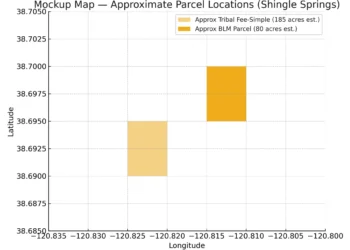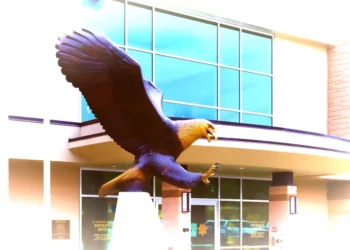Placerville, Calif. —
A young man mountain biking deep in the Carson Iceberg Wilderness suffered a crash this past Sunday evening that left him injured and unable to self-extract, Alpine County authorities reported. Following a cold night alone at elevation and concerns of hypothermia, a coordinated air and ground rescue brought him to safety.
The Alpine County Sheriff’s Office Search and Rescue, supported by the California Governor’s Office of Emergency Services, launched the effort shortly after the accident. The following morning, with ground teams having hiked over ten hours through steep canyon terrain, responders made the decision to deploy Echo 1, an aerial hoist capable helicopter rescue unit.
Echo 1’s crew located the injured biker at more than 9,000 feet elevation in a steep canyon. An Emergency/Rescue Technician and EMT from Alpine County was lowered via hoist, made contact, and conducted a medical assessment. The victim was then hoisted aboard Echo 1, flown to waiting deputies, medically cleared, and reunited with his family.
“We’re grateful the weather held and that the hoist went smoothly. Without that air rescue, things could have ended much worse,” said a spokesperson for the Alpine County Sheriff’s Office.
Authorities did not release the bicyclist’s name pending family notification. The Alpine County Sheriff’s Office reminded backcountry visitors to carry proper gear, check weather forecasts, and know the limits of cell service before venturing into remote terrain. Wilderness conditions at high elevation can become life-threatening after dark.
El Dorado County shares public land and community ties with Alpine County, especially among outdoors enthusiasts who frequent the Sierra Nevada backcountry. Knowing how these rescues unfold highlights the critical importance of preparedness—and the resources at play when emergencies arise in rugged wilderness areas.
Who / What is Echo 1
-
Operator & Acquisition: Echo 1 is a helicopter (Airbus H-125 / “AStar”) operated by the El Dorado County Sheriff’s Office (EDSO) as part of its aviation/search and rescue (SAR) program.
-
When in Service: The unit formally began flying in May 2024.
-
Hoist Certification: Certified for hoist rescues as of July 2024.
Capabilities & Equipment
Echo 1 is outfitted for difficult rescue scenarios, especially in remote or rugged terrain, and in low-light/nighttime conditions. Key features include:
-
Advanced navigation systems.
-
Infrared cameras and night vision equipment.
-
A 200-foot beam light for illumination in dark/rescue operations.
-
A hoist system, enabling lifting / lowering rescuers or victims in vertical terrain where landing is not possible.
-
High-altitude capabilities and relatively fast speed (max approx. 126 mph) to get to remote areas quickly.
Recent Missions & Operational Statistics
Since its introduction, Echo 1 has already accumulated a considerable mission history despite being relatively new.
Rescue Count & Types:
-
As of early 2025, the unit has conducted about 15 rescue missions. Of those, 13 were hoist rescues and 2 were remote landing rescues (i.e. situations where Echo 1 could land rather than hoist someone).
-
Examples of missions include:
-
A hiker stuck on a rock outcropping above Angora Lakes, who required a hoist to extract because he was off-trail and trapped on a ledge.
-
Rescues of hikers and climbers in difficult terrain – e.g. those stuck at cliff faces such as Sugarloaf near Kyburz.
-
Training & Preparedness:
-
Echo 1’s crew undergoes specialized training, particularly for night hoist operations. In mid-2025, EDSO conducted joint training exercises with SR3 Rescue Concepts to sharpen night-time rescue capabilities.
-
The training emphasizes precision, coordination between hoist operator, pilot, and rescue technician, especially given the higher risks when doing hoist work at night.
Budget, Coverage & Operational Context
-
Coverage Area: The helicopter operates across all of El Dorado County, an area of about 1,786 square miles, with varied terrain (from foothills to high mountains) which makes ground rescue challenging.
-
Operating Cost: Annual operating costs are approximately $800,000, funded through the Sheriff’s Office budget.
-
Community & Policy Goals: One of the goals is to improve response times for SAR, especially in remote/steep/vertical terrain, reducing risk to both victims and rescuers. Another goal is to expand service frequencies (aiming for more regular availability).
Hoisting is the most dangerous thing you can do with a helicopter,” said Pilot Deputy Joe Brown. “However, sometimes it is the tool that you need from that toolbox to get a person to higher care.”
How Echo 1 Compares & Why It Matters
-
Previously, many remote rescues in El Dorado County had to rely entirely on ground crews — long hikes, sometimes technical climbing or rope-work, which could take hours or even tens of hours. Echo 1 enables faster access, often lifesaving in cold, steep, or medically urgent conditions.
-
In winter or at high elevation, or in steep terrain, landing might not be possible — so hoist capability, night vision, etc., are critical tools. Echo 1 brings those tools locally.










